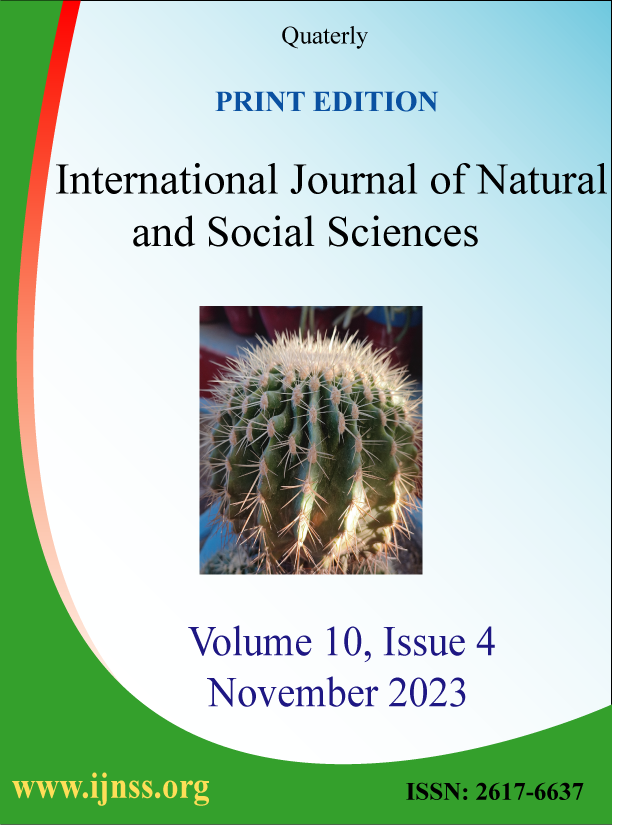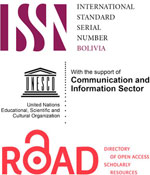Causes and possible solutions of poverty perceived by char dwellers in Bangladesh
Volume 2, Issue 1, February 2015, Pages 37–41
Md. Nazirul Islam Sarker1,4,![]()
![]() Md. Arshad Ali2, Md. Shahidul Islam3
Md. Arshad Ali2, Md. Shahidul Islam3
1Ex-Program Officer, Chars Livelihood Program (CLP), Jamalpur, Bangladesh
2Department of Entomology, Bangladesh Agricultural University, Mymensingh-2202, Bangladesh
3Department of Plant Pathology, Bangladesh Agricultural University, Mymensingh-2202, Bangladesh
4Department of Agricultural Extension Education. Bangladesh Agricultural University, Mymensingh-2202, Bangladesh
| ABSTRACT | Get Full Text PDF |
The study was carried out in Patilbari village of Shaghata upazila under Gaibandha district and Char Monnia of Islampur upazila in Jamalpur district to determine the causes of poverty of char dwellers. The study was aimed to ascertain the probable ways for alleviating poverty and the dimensions of poverty faced by the char dwellers in Bangladesh. One hundred CLP (Chars Livelihoods Programme) beneficiaries were selected randomly of which 50 from Patilbari village and another 50 from Char Monnia village. Data were collected during January-March 2008 through interview schedule. Among the 25 causes of poverty riverbank erosion, frequent flood inundation, inadequate educational opportunity, encroachment of char land by terrorist, diseases of cattle, goats and sheep etc. are the main causes of poverty. Among 20 possible ways of alleviating poverty, control of river bank erosion, ensured educational facilities, increasing cultivable land by proper management, improved communication and transport facilities, control of diseases of cattle, goats and sheep etc came out as the main ways. The study will help policy maker and NGOs to address and analyze the issues for poverty alleviation of char dwellers.
Key words: Poverty, poverty alleviation, char dwellers, Bangladesh.
![]() Corresponding author. Tel.: +8801719002750
Corresponding author. Tel.: +8801719002750
E-mail address: nazirul2012@gmail.com (MNI Sarker)
How to cite this article: MNI Sarker, MA Ali and MS Islam (2015). Causes and possible solutions of poverty perceived by char dwellers in Bangladesh. International Journal of Natural and Social Sciences, 2(1): 37-41.
INTRODUCTION
Bangladesh is one of the most densely populated countries in the world with a population of over 150 million living in an area of 147,570 square kilometres (or 1,045 persons per square kilometre). About 80% of the population lives in rural areas and is mainly engaged in agriculture and related non-farm activities. More than two thirds of the rural population is landless or functionally landless (owning less than 0.2 hectares of land), 44% are below the national poverty line and 29% are classified as very poor. Endowed with limited land and other natural resources, and with a high population density, poverty is a pervasive problem in rural Bangladesh.(BBS, 2005).
A Char is a strip of land or a bar which has emerged from the river-bed following deposition and accretion of silt and alluvium. Chars can be of two types: attached and island chars. An island char is defined as that land which even in the dry season, can only be reached from the mainland crossing a main river channel. Attached chars are accessible from the mainland without crossing a channel during the dry season (Sarker et. al., 2007).
Bangladesh is a riverine country. About 230 rivers exist in this country as like net. Most of the rivers possess a number of char areas. The char dwellers are facing with the problem of poverty which manifests itself in landlessness, unemployment, illiteracy, malnutrition and vulnerability to frequent natural disasters. The instability of the chars in the Jamuna is inherent in the dynamic characteristics of this braided river. The earthquake of 1950 in Assam and adjacent areas might also have contributed to the instability of the Jamuna chars. However, 5% to 7% of total population of our country lives in these char areas. The majority of these people (65%) live in the Jamuna chars. It is to be noted that the population density of chars is less than half of the national average in Bangladesh. The socio-economic condition of people living in chars varies widely between rivers and sometimes even between the upper, middle and lower reaches of the same river. The chars are poorly connected to the main land and are prone to acute erosion and flooding which make the inhabitants feel vulnerable. The life of the char people is closely related to variations in the dynamics of rivers and char formation as well as the associated erosion and flood hazards. Each of the year’s large percentage of the chars gets flooded. The flooding if it comes early can damage the crops in the fields. People in chars build their homesteads on the highest available land and if they stay there for any length of time, they further elevate their homesteads on built-up plinths to avoid annual inundation. The typical patterns of physical development and human use of land and other resources in the chars differ among the different river system of Bangladesh. Such a wide network of rivers plays a pivotal role in the livelihoods of people, particularly of those who live in riverbanks and chars lands. The present study was undertaken to find out the causes and of poverty of char dwellers and ascertain the probable ways for alleviating poverty. The study will help to identify the dimensions of poverty faced by the char dwellers in Bangladesh.
METHODOLOGY
Study area
The study was conducted in Patilbari village of Shaghata upazila in Gaibandha district and Char Monnia of Islampur upazila in Jamalpur district. The study areas were two island chars in different districts embedded on Jamuna river. The physical, social and cultural heritages of the people of this area similar in many cases with other char areas of the country.
Data collection
The sample size was 100 of which 50 from Patilbari village of Gaibandha district and another 50 from Char Monnia of Jamalpur district. The sample size was determined by the estimated proportion formula (Cochran 1977). The interview was conducted by asking the respective household head or representative. The households are temporarily or permanently residing in the char areas. An interview schedule was carefully prepared keeping objectives in mind. Simple and direct questions and different scales were used to obtain information. The information supplied by the respondents was recorded directly on the interview schedule. The information was duly checked in order to minimize errors if any. The respondents were interviewed at their leisure time to get maximum information. After collecting data, the researcher made careful scrutiny in all the schedules. The data were collected during January to March, 2008. All the collected data were checked and cross checked before transferred into the master sheets. The data were coded, compiled, tabulated and analyzed to accomplish the specific objectives of the study. Qualitative data were converted into quantitative form by means of suitable scoring technique whenever applicable. Secondary data have been accumulated from different published journals and books.
RESULTS AND DISCUSSION
Causes of poverty
The CLP beneficiaries were asked to mention the causes of poverty they faced, each of the respondents cited five causes. They have mentioned twenty five causes of their poverty which have been presented in table 1.
River bank erosion was the top most cause of poverty as cited by 95 respondents in this study. Due to riverbank erosion every year unemployment, landless and poverty are increasing which is responsible to country wide unstable condition (Rahman 2010). It has been estimated that tens of thousands of people are displaced annually by river erosion in Bangladesh, possibly up to 100,000.
Table 1
The causes of poverty of char dwellers as perceived by them.
| Sl. No. | Causes of poverty | Number of citation | Rank |
| 1 | River bank erosion | 94 | 1 |
| 2 | Frequent flood inundation | 68 | 2 |
| 3 | Inadequate educational facilities | 45 | 3 |
| 4 | Encroachment of char land by terrorist. | 29 | 4 |
| 5 | Diseases of cattle, goats and sheep | 28 | 5 |
| 6 | High rate of interest on borrowing invested by the vested group | 26 | 6.5 |
| 7 | Lack of cultivable land due to sandy soil | 26 | 6.5 |
| 8 | Over population | 23 | 8 |
| 9 | Dowry system | 19 | 9 |
| 10 | Drought causes food crisis | 18 | 10.5 |
| 11 | Poor communication facilities | 18 | 10.5 |
| 12 | Diseases and insects attack on crops | 17 | 12 |
| 13 | Lack of employment opportunity | 15 | 13 |
| 14 | Diseases of poultry birds | 13 | 14 |
| 15 | Marriage of under aged people | 11 | 15 |
| 16 | Benefit from actual wages | 9 | 17 |
| 17 | Lack of capital for cultivation of crops and business | 9 | 17 |
| 18 | Frequent cyclone | 9 | 17 |
| 19 | Laziness of char dwellers | 8 | 19 |
| 20 | Migration of char dwellers | 6 | 20.5 |
| 21 | Lack of self awareness | 6 | 20.5 |
| 22 | Lack of willingness of service providing agencies | 5 | 22.5 |
| 23 | Running of cases | 4 | 22.5 |
| 24 | Inheritance of poverty | 5 | 24.5 |
| 25 | Lack of knowledge about land law | 4 | 24.5 |
Frequent flood inundation is the second most cause of poverty for char dweller. Poverty and idiosyncratic flood risk are positively correlated and highly significant (Rayhan, 2010). Above 16 to 70 percent of flooded households fall into poverty after flood depending on the situation and locations (Rayhan, 2010). Houses are damaged during floods and their assets like livestock, crops and boats are in risk every year. This increases the vulnerability of the local population.
An inadequate education facility is ranked 3 as a cause of poverty of char land people. Education is considered the most significant variable to define vulnerability. The households with higher educated member are less vulnerable. The increase of 1 unit educational year of highest educated member of household decreases 24 unit vulnerability to flood, most of this reduction is appeared in poverty (Rayhan, 2010).
Table 2
The possible ways of poverty alleviation of char dwellers as perceived by them.
| Sl. No. | Possible ways of poverty alleviation | Number of citation | Rank |
| 1 | Control of river bank erosion | 95 | 1 |
| 2 | Ensured educational facilities | 65 | 2 |
| 3 | Increasing cultivable land by proper management. | 44 | 3 |
| 4 | Communication and transport facilities should be increased | 33 | 4 |
| 5 | Control of diseases of cattle, goats and sheep | 40 | 5 |
| 6 | Control of land encroachment | 35 | 6 |
| 7 | Control of high rate of interest on borrowing money | 30 | 7 |
| 8 | Capital for cultivation of crops and business should be ensured | 25 | 8 |
| 9 | Self awareness among char dwellers should be increased | 23 | 9 |
| 10 | Control of diseases of poultry birds | 22 | 10 |
| 11 | Increase employment opportunities | 19 | 11 |
| 12 | Population growth control | 18 | 12 |
| 13 | Protect dowry system | 9 | 13 |
| 14 | Control of diseases and insect attack of crops | 15 | 14 |
| 15 | Embankment should be constructed to protect flood | 13 | 15 |
| 16 | Control of under aged marriage | 9 | 16 |
| 17 | Land law should be known | 6 | 17 |
| 18 | Flood rehabilitation shelter should be constructed. | 5 | 18 |
| 19 | Need service providing agencies | 4 | 19 |
| 20 | Regular migration should be protested | 3 | 20 |
Aftermath flood disease causes severe health hazards of human and animal. The disease causes loss of production and economy that lead to poverty of char dwellers.
Beneft from actual wages was another cause of poverty as responded by 9% households in the study area. Wage laborers often suffer during floods, because the scopes of work and wage rates shrink at that time. It is estimated that real wages fall by more than 10 percent during the floods (Azam 1993).
The most direct disastrous impact of flooding in Bangladesh arises from damage to standing crops, affecting the small farm holders significantly. As a consequence, poorer households fall into debt and lastly choose to migrate in nearby cities to enhance their livelihoods. Historic studies from the mid 1980s indicate that in some slums in Dhaka more than 40% of the population named river erosion as primary cause for their migration into slums. In a study by Islam (2012) the majority (65.21%) of the respondents were migrated due to river bank erosion of Tista flood plain areas.
Respondents cited laziness of char dwellers, lack of self awareness, lack of willingness of service providing agencies, and inheritance of poverty as minor causes of poverty in char land. Due to lack of education, regular loss of land and undeveloped communication facilities with a number of causes, they become more vulnerable class of the society compared to plain land people. Along with the major causes the continuous rapid population growth and shrinking land resources and productivity, development of rural people and poverty alleviation is a crucial issue in char land areas.
Poverty alleviation
The Char dwellers were asked to mention the possible ways of poverty alleviation as perceived by them, each of the respondents cited five ways. They have mentioned twenty possible ways of poverty alleviation which have been presented in table 2.
The bio-physical condition and location of the chars make it quite easy to understand that human life on these geographical settings is neither convenient nor easy. Isolation from main land and associated attributes, lack of infrastructure, disaster prone nature, and powerlessness interlock the char dwellers into a downward spiral of poverty. This state of deadlocked poverty has been seen to be quite persistent due to the lack of adequate institutional intervention (Chowdhury 1988). The majority of the respondents in this study mentioned that control of river bank erosion, ensured educational facilities, increasing cultivable land by proper management, improved communication and transport facilities, control of diseases of cattle, goats and sheep etc. are the possible ways for poverty alleviation in the island char areas (Table 2). However, the study suggest the government, NGOs or any other social organization having intension to alleviate the poverty of char dwellers should address the causes and their sustainable solution in priority basis.
REFERENCES
Azam JP (1993). The impact of floods on rural real wages in Bangladesh,The Bangladesh Development Studies, XXI 1 :1-14.
BBS (2005). Statistical Pocket Book of Bangladesh. Bangladesh Bureau of Statistics, Ministry of Planning, Government of the People’s Republic of Bangladesh.
Chambers R (1983). Rural Development: Putting the first last. Longman Intermediate Technology Publications. London.
Chowdhury EH (1988). Human adjustments to river bank erosion hazard in the Jamuna floodplain, Bangladesh. Human Ecology 16 (4):421-37, doi:10.1007/BF00891651.
Islam M (2012) Impact of char development on agricultural productivity, livelihood status and environmental adaptations of char land dwellers around the Tista flood plain areas of Rangpur district. MS thesis, Department of Environmental Science Bangladesh Agricultural University, Mymensingh-2202.
Kashem MA (2004). Fundamentals of Extension Education. Lima Printing Press. Mymensingh, Bangladesh.
Rahman MR (2010). Impact of riverbank erosion hazard in the Jamuna floodplain areas in Bangladesh Journal of Science Foundation, 8(1&2): 55-65.
Rayhan MI (2010). Assessing poverty, risk and vulnerability: A study on the Flooded Households in Rural Bangladesh. Journal of Flood Risk Management, 3(1) .
Sarker MNI, Kashem MA and Rahman MZ (2007). Poverty alleviation of rural people through chars livelihoods program. Journal of Bangladesh Society of Agricultural Science and Technology, 4(3&4): 203-208.
William G. Cochran (1977). Sampling Techniques, 3rd Edition, John Wiley, pp 75.






